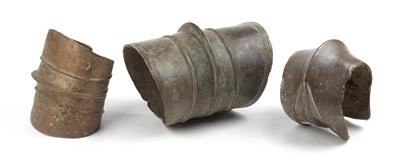Mixed lot (3 items): Dem. Rep. of Congo; tribes: Mongo,

Konda, Kutu and Kota: Three ‘Konga anklets’ for women, also used as valuable objects (‘primitive money’). Heavy anklets such as the present ones, called ‘Konga’, were cast in bronze (copper-tin alloys in different grades) by the blacksmiths of the aforementioned tribes in central Congo. For this purpose, flat wooden moulds, in which the characteristic ridges had already been carved, were pressed into the sandy soil. Metal was then cast into these negative forms. Once the plates had cooled down, a blacksmith would place them over a trunk and hammer them into an open round shape, subsequently adapting them directly to a woman’s leg. The leg was wrapped in fabrics at the lower edge of the heavy anklet in order to prevent injuries. Only women from well-off families of the upper classes would wear these anklets. In earlier days, ‘Konga bangles’ were also used as a form of currency (‘primitive money’) in central Congo.
The present three ‘Konga anklets’ have good usage patina (on the inside!). The largest among them also features an additional line decoration engraved on the outer edges.
Between the 19th century and the first third of the 20th century; H: 21.5 cm, 15 cm, 11 cm. Weight: 3.5 kg; 3.3 kg; 1.3 kg. (ME)
Provenance: Austrian Private Collection. Literature: 'The perfect Form' by Roberto Ballarini, fig. p. 268, 269.
Specialist: Erwin Melchardt
 Erwin Melchardt
Erwin Melchardt
+43-1-515 60-465
erwin.melchardt@dorotheum.at
26.05.2015 - 15:00
- Estimate:
-
EUR 1,000.- to EUR 1,200.-
Mixed lot (3 items): Dem. Rep. of Congo; tribes: Mongo,
Konda, Kutu and Kota: Three ‘Konga anklets’ for women, also used as valuable objects (‘primitive money’). Heavy anklets such as the present ones, called ‘Konga’, were cast in bronze (copper-tin alloys in different grades) by the blacksmiths of the aforementioned tribes in central Congo. For this purpose, flat wooden moulds, in which the characteristic ridges had already been carved, were pressed into the sandy soil. Metal was then cast into these negative forms. Once the plates had cooled down, a blacksmith would place them over a trunk and hammer them into an open round shape, subsequently adapting them directly to a woman’s leg. The leg was wrapped in fabrics at the lower edge of the heavy anklet in order to prevent injuries. Only women from well-off families of the upper classes would wear these anklets. In earlier days, ‘Konga bangles’ were also used as a form of currency (‘primitive money’) in central Congo.
The present three ‘Konga anklets’ have good usage patina (on the inside!). The largest among them also features an additional line decoration engraved on the outer edges.
Between the 19th century and the first third of the 20th century; H: 21.5 cm, 15 cm, 11 cm. Weight: 3.5 kg; 3.3 kg; 1.3 kg. (ME)
Provenance: Austrian Private Collection. Literature: 'The perfect Form' by Roberto Ballarini, fig. p. 268, 269.
Specialist: Erwin Melchardt
 Erwin Melchardt
Erwin Melchardt
+43-1-515 60-465
erwin.melchardt@dorotheum.at
|
Buyers hotline
Mon.-Fri.: 10.00am - 5.00pm
kundendienst@dorotheum.at +43 1 515 60 200 |
| Auction: | Tribal Art |
| Auction type: | Saleroom auction |
| Date: | 26.05.2015 - 15:00 |
| Location: | Vienna | Palais Dorotheum |
| Exhibition: | 20.05. - 26.05.2015 |
